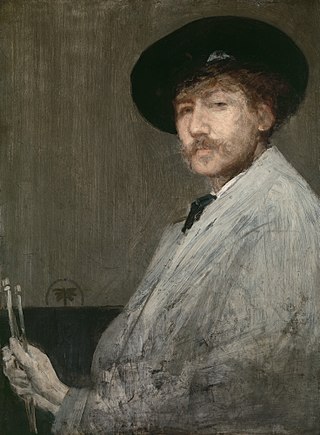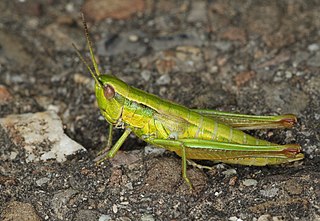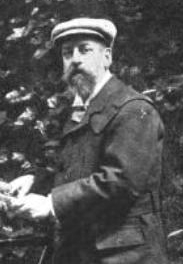
James Abbott McNeill Whistler was an American painter in oils and watercolor, and printmaker, active during the American Gilded Age and based primarily in the United Kingdom. He eschewed sentimentality and moral allusion in painting and was a leading proponent of the credo "art for art's sake".

Arthur Christopher Benson, was an English essayist, poet and academic, and the 28th Master of Magdalene College, Cambridge. He wrote the lyrics of Edward Elgar's Coronation Ode, including the words of the patriotic song "Land of Hope and Glory" (1902). His literary criticism, poems, and volumes of essays were highly regarded. He was also noted as an author of ghost stories.

Joseph Pennell was an American draftsman, etcher, lithographer, and illustrator for books and magazines. A prolific artist, he spent most of his working life in Europe, and developed an interest in landmarks, landscapes, and industrial scenes around the world. A student of James Lambdin and Thomas Eakins, he was later influenced by James McNeill Whistler. He was married to author Elizabeth Robins, and he also was a writer.
Henry Benjamin Wheatley FSA was a British author, editor, and indexer. His London Past and Present was described as his most important work and "the standard dictionary of London."

Elizabeth Robins Pennell was an American writer who, for most of her adult life, made her home in London. A researcher summed her up in a work published in 2000 as "an adventurous, accomplished, self-assured, well-known columnist, biographer, cookbook collector, and art critic"; in addition, she wrote travelogues, mainly of European cycling voyages, and memoirs, centred on her London salon. Her biographies included the first in almost a century of the proto-feminist Mary Wollstonecraft, one of her uncle the folklorist Charles Godfrey Leland, and one of her friend the painter Whistler. In recent years, her art criticism has come under scrutiny, and her food criticism has been reprinted.

Joseph William Comyns Carr, often referred to as J. Comyns Carr, was an English drama and art critic, gallery director, author, poet, playwright and theatre manager.

Charles Whibley was an English literary journalist and author. In literature and the arts, his views were progressive. He supported James Abbott McNeill Whistler. He also recommended T. S. Eliot to Geoffrey Faber, which resulted in Eliot's being appointed as an editor at Faber and Gwyer. Eliot's essay Charles Whibley (1931) was contained within his Selected Essays, 1917-1932. Whibley's style was described by Matthew as "often acerbic high Tory commentary".
Vincent Brooks, Day & Son was a major British lithographic firm most widely known for reproducing the weekly caricatures published in Vanity Fair magazine. The company was formed in 1867 when Vincent Brooks bought the name, good will and some of the property of Day & Son Ltd, which had gone into liquidation that year. The firm reproduced artwork and illustrations and went on to print many of the iconic London Underground posters of the twenties and thirties before being wound up in 1940.

Gomphocerinae, sometimes called "slant-faced grasshoppers", are a subfamily of grasshoppers found on every continent but Antarctica and Australia.

Arthur Jerome Eddy was an American lawyer, author, art collector, and a prominent member of the first generation of American Modern art collectors. His book Cubists and Post-Impressionism was the first American book promoting these new art movements and the work of Wassily Kandinsky. Eddy's collection was distinguished by the inclusion of German expressionists and Wassily Kandinsky.

Ethel Whibley, was the sister-in-law of James McNeill Whistler. Ethel was a secretary to Whistler who used Ethel as a model for a number of full-length portraits painted during the period 1888 to the mid-1890s. Her sister Beatrice married James McNeill Whistler in 1888, following the death of her first husband Edward William Godwin. In 1896 Ethel married the writer Charles Whibley. Her sister Rosalind Birnie Philip (1873-1958) subsequently acted as secretary to Whistler and was appointed Whistler's executrix at his death.

Grundmann Studios (1893–1917) in Boston, Massachusetts, was a building on Clarendon Street in the Back Bay. It contained artist's workspaces and multipurpose function rooms Copley Hall and Allston Hall. Prior to 1893, it functioned as a skating rink; after the Boston Art Students' Association leased the building it was renamed in honor of local art educator Emil Otto Grundmann. The Massachusetts Institute of Technology, whose campus was adjacent, owned the property. Tenants included the Copley Society ; artists Henry R. Blaney, Herman Dudley Murphy, Frank Richmond, Mary Bradish Titcomb; sculptor John A. Wilson, architect Josephine Wright Chapman; and the College Club.
The International Society of Sculptors, Painters and Gravers was a union of professional artists that existed from 1898 to 1925, "To promote the study, practice, and knowledge of sculpture, painting, etching, lithographing, engraving, and kindred arts in England or elsewhere...". It came to be known simply as The International. The society organised exhibitions, some for members only and some open to others, and social events such as musical evenings and soirées. The exhibitions were held in a number of London venues, and in other cities around England, including Nottingham and Manchester. Its founder and first president was James McNeill Whistler. On his death, the presidency was taken up by Auguste Rodin, with John Lavery as vice-president. The society contributed £500 towards the cost of Whistler's memorial.

Thomas Armstrong (1832–1911) was an English artist and arts administrator.

William McNeill Whistler was an American physician and a medical army officer for the Confederacy during the American Civil War. He was the younger brother of artist James McNeill Whistler.

Sir James Dromgole Linton (1840–1916) was an English painter in oil and watercolour, and a lithographer.

The Pantheon, from the Terrace of the Luxembourg Gardens is a lithograph by the American artist James Abbott McNeill Whistler, created in 1893.














